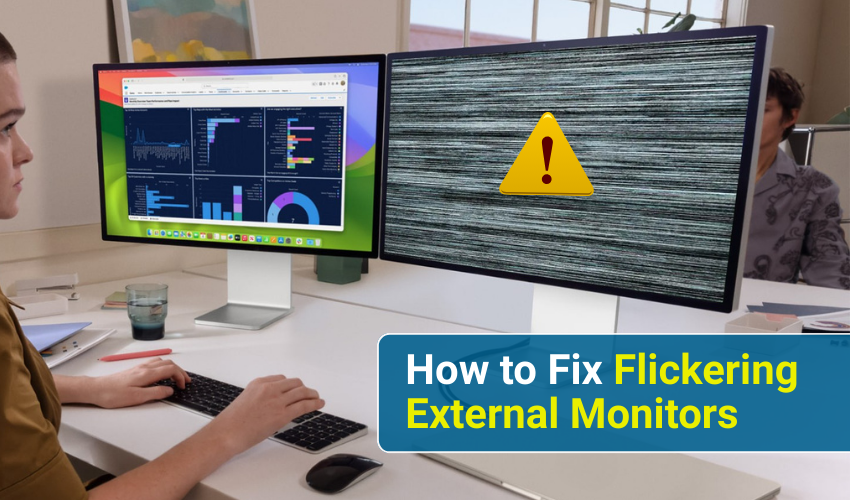How to fix flickering external monitors

How to Fix Flickering External Monitors: A Step-by-Step Guide
If you use an external screen with your computer or laptop, you may have faced an annoying problem: the screen starts to flicker. This means the picture on the monitor keeps flashing, going dim, or showing lines that make it hard to see anything clearly.
The good news is that you don’t need to be a computer expert to fix flickering external monitors. With the right steps, you can solve this screen issue yourself at home. In this guide, I will explain what causes monitor flicker and how you can do an external display fix without feeling lost.
Why Does Monitor Flicker Happen?
Before we look at the solutions, let’s understand why this problem happens in the first place. Knowing the cause makes it easier to apply the right fix.
- Loose or Damaged Cables
The wire that connects your computer to the external monitor may not be plugged in properly, or it could be damaged.
- Wrong Display Settings
Computers use something called a “refresh rate.” If the refresh rate is set too low or is not supported by your monitor, the screen may flicker.
- Graphics Driver Problems
The graphics driver is software that controls how pictures appear on your screen. If this driver is old or corrupted, it can cause flickering.
- Hardware Limitations
Some laptops or desktops may not support very high resolutions on an external monitor, which can also lead to screen issues.
- Interference
Other electronic devices placed close to your monitor (like Wi-Fi routers, speakers, or phones) can sometimes cause flicker.
Step 1: Check the Monitor Cable
The first thing you should do to fix flickering external monitors is to check the connecting cable.
- Turn off your computer and monitor.
- Unplug the cable from both ends.
- Look closely to see if the pins are bent or broken.
- If the cable looks fine, plug it back in firmly.
- If you see damage, replace the cable with a new one.
For most modern monitors, the cables used are HDMI, DisplayPort, USB-C, or VGA. If your current cable is very old, upgrading to a better quality cable may solve the monitor flicker instantly.
Step 2: Adjust the Refresh Rate
The refresh rate is the speed at which your screen updates images every second. If it is set too low, the external monitor will flicker.
Here’s how to check and fix it on Windows:
- Right-click on your desktop and select Display settings.
- Scroll down and click on Advanced display settings.
- Find the option for Refresh rate.
- Select a higher number, usually 60 Hz or more.
On Mac:
- Open System Preferences.
- Go to Displays.
- Hold the Option key and click Scaled to see refresh rate options.
- Choose the recommended one, often 60 Hz.
This small adjustment often fixes the screen issue right away.
Step 3: Update the Graphics Driver
The graphics driver controls how your computer sends images to the external display. If the driver is outdated, you may see monitor flicker.
On Windows:
- Click on the Start menu.
- Type Device Manager and open it.
- Expand Display adapters.
- Right-click your graphics card and choose Update driver.
- Follow the on-screen steps.
On Mac, drivers usually update with system updates.
- Go to System Preferences > Software Update and install any available updates.
Step 4: Test with a Different Monitor or Device
Sometimes, the problem is not your computer but the monitor itself. To check this:
- Connect your computer to another external monitor, if you have one.
- If the flickering stops, then your first monitor may need servicing.
- You can also try connecting another device (like a different laptop) to your flickering monitor. If it still flickers, the issue is with the monitor.
This quick test helps you know whether you need an external display fix or a replacement.
Step 5: Reduce Electronic Interference
Other devices around your monitor may create interference that causes screen flicker.
- Keep your Wi-Fi router, cordless phones, and large speakers away from your external screen.
- Place the monitor in a clean space with fewer electronic items around it.
Step 6: Lower the Screen Resolution
If your computer is pushing a resolution higher than what the monitor supports, it may cause flickering.
On Windows:
- Right-click the desktop, choose Display settings.
- Scroll to Display resolution.
- Select the recommended option (it usually says “Recommended” next to it).
On Mac:
- Go to System Preferences > Displays.
- Choose the Default for display option.
This sets the monitor to the safest resolution.
Step 7: Consider Monitor Age
If your external monitor is more than 7–10 years old, flickering may simply be a sign of aging hardware. Older monitors sometimes cannot handle modern connections or refresh rates. In such cases, replacing the monitor might be the best external display fix.
When to Seek Professional Help
If you have tried all the steps above and the screen issue continues, it may be time to get professional help. Contact a computer repair service or the monitor manufacturer’s support team. Tell them exactly what you tried so they can assist you better.
Final Thoughts
It can feel stressful to deal with flickering external monitors, but most of the time, the solution is simple. Start with easy checks like cables and refresh rate, then move to updates and interference. In many cases, you can solve the monitor flicker problem in less than 30 minutes without needing expensive repairs.
By following this guide step by step, you now have all the information needed for an external display fix. Whether the screen issue comes from cables, settings, or hardware, you can handle it calmly and confidently.
